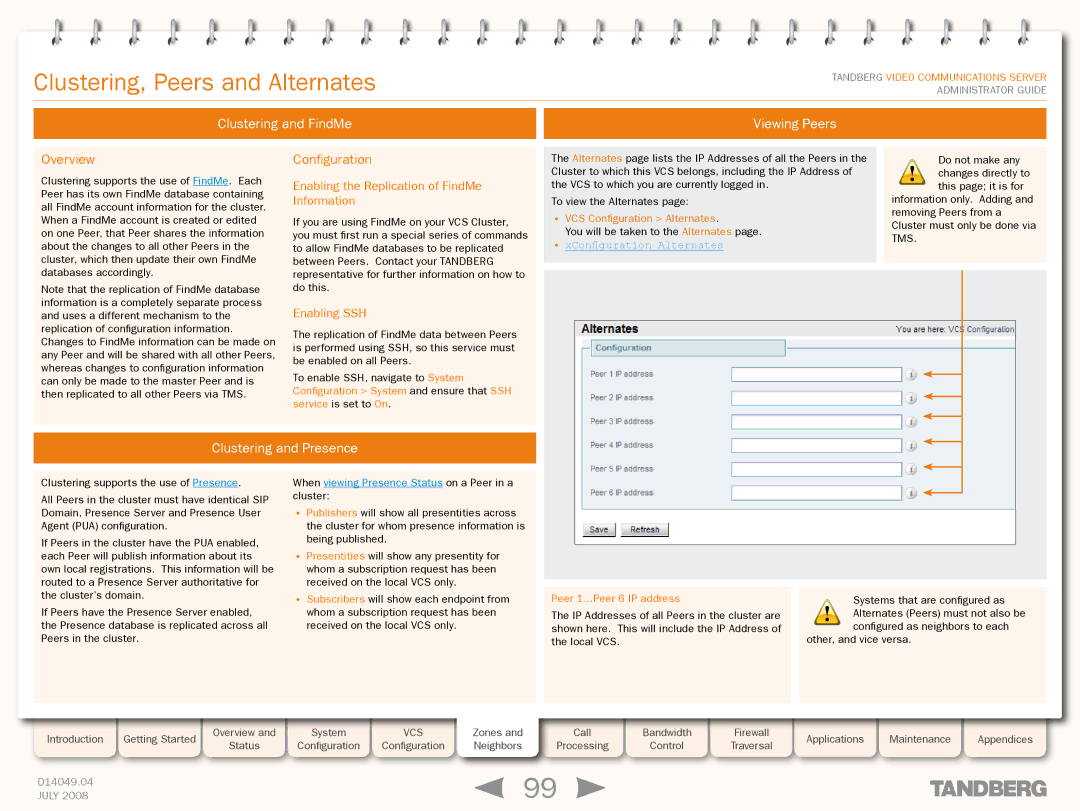
Grey Headline (continued)
Clustering, Peers and Alternates
TANDBERG VIDEO COMMUNICATIONS SERVER ADMINISTRATOR GUIDE
Clustering and FindMe
Viewing Peers
Overview
Clustering supports the use of FindMe. Each Peer has its own FindMe database containing all FindMe account information for the cluster. When a FindMe account is created or edited on one Peer, that Peer shares the information about the changes to all other Peers in the cluster, which then update their own FindMe databases accordingly.
Note that the replication of FindMe database information is a completely separate process and uses a different mechanism to the replication of configuration information. Changes to FindMe information can be made on any Peer and will be shared with all other Peers, whereas changes to configuration information can only be made to the master Peer and is then replicated to all other Peers via TMS.
Configuration
Enabling the Replication of FindMe Information
If you are using FindMe on your VCS Cluster, you must first run a special series of commands to allow FindMe databases to be replicated between Peers. Contact your TANDBERG representative for further information on how to do this.
Enabling SSH
The replication of FindMe data between Peers is performed using SSH, so this service must be enabled on all Peers.
To enable SSH, navigate to System Configuration > System and ensure that SSH service is set to On.
The Alternates page lists the IP Addresses of all the Peers in the Cluster to which this VCS belongs, including the IP Address of the VCS to which you are currently logged in.
To view the Alternates page:
•VCS Configuration > Alternates.
You will be taken to the Alternates page.
•xConfiguration Alternates
!changes directly to this page; it is forDo not make any
information only. Adding and removing Peers from a Cluster must only be done via TMS.
Clustering and Presence
Clustering supports the use of Presence.
All Peers in the cluster must have identical SIP Domain, Presence Server and Presence User Agent (PUA) configuration.
If Peers in the cluster have the PUA enabled, each Peer will publish information about its own local registrations. This information will be routed to a Presence Server authoritative for the cluster’s domain.
If Peers have the Presence Server enabled, the Presence database is replicated across all Peers in the cluster.
When viewing Presence Status on a Peer in a cluster:
•Publishers will show all presentities across the cluster for whom presence information is being published.
•Presentities will show any presentity for whom a subscription request has been received on the local VCS only.
•Subscribers will show each endpoint from whom a subscription request has been received on the local VCS only.
Peer 1...Peer 6 IP address |
| ! | Systems that are configured as |
The IP Addresses of all Peers in the cluster are |
| Alternates (Peers) must not also be | |
| configured as neighbors to each | ||
shown here. This will include the IP Address of |
|
| |
the local VCS. |
| other, and vice versa. | |
|
|
|
|
Introduction | Getting Started |
| Overview and |
| System |
| VCS | Zones and | Call |
| Bandwidth |
| Firewall |
| Applications |
| Maintenance |
| Appendices |
| Status |
| Configuration |
| Configuration | Neighbors | Processing |
| Control |
| Traversal |
|
|
| |||||
|
|
|
|
|
|
|
|
|
|
|
|
| |||||||
|
|
|
|
|
|
|
|
|
|
|
|
|
|
|
|
|
|
|
|
D14049.04 |
|
|
|
|
|
|
| 99 |
|
|
|
|
|
|
|
|
|
| |
JULY 2008 |
|
|
|
|
|
|
|
|
|
|
|
|
|
|
|
|
| ||
